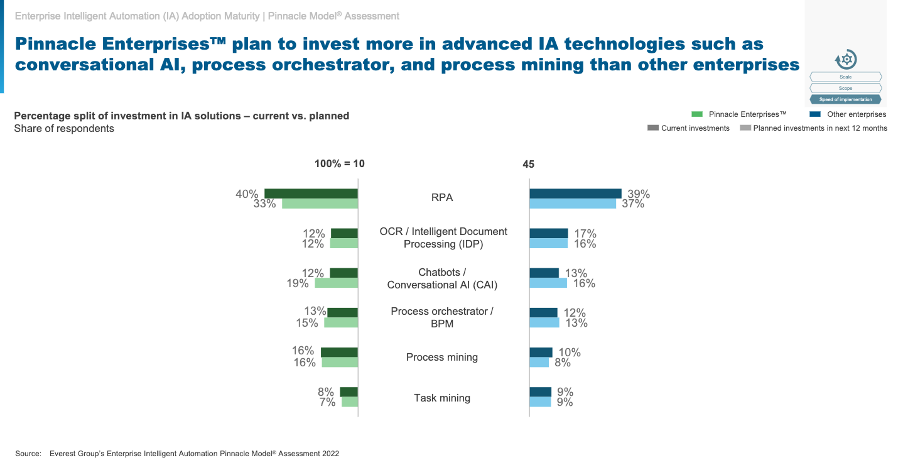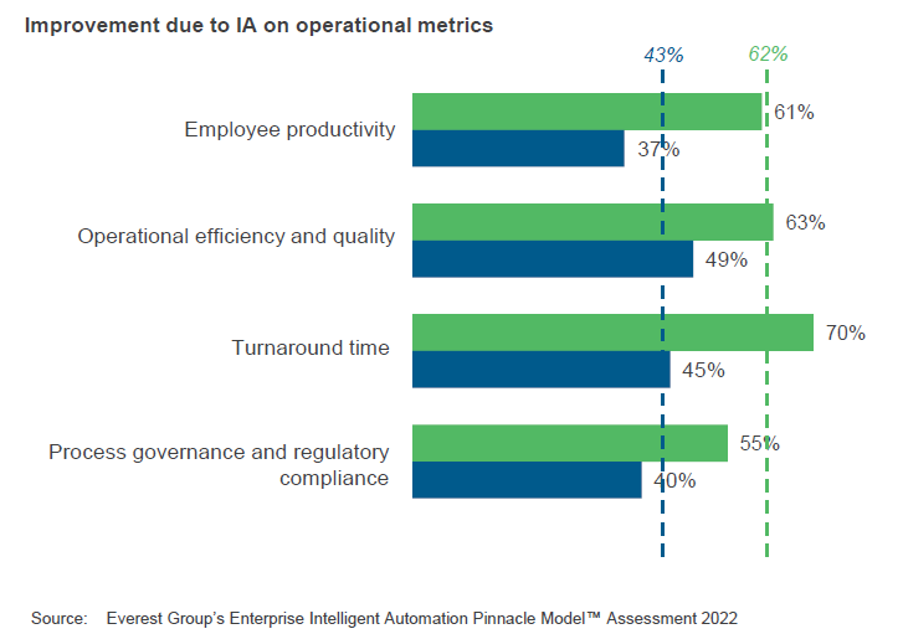White Paper
Everest Report: From Hype to Reality
Contact Us
A new Everest Group Pinnacle Model® study supported by SS&C Blue Prism has unveiled the financial, operational and strategic benefits businesses realize by investing in advanced enterprise automation capabilities.
Business process automation has become imperative for businesses to maintain competitiveness and agility. The latest Pinnacle Model study shows that enterprises that prioritize developing their intelligent automation (IA) capabilities see the most improvements in operational efficiency, employee productivity and customer experience, which are the key drivers for adopting IA.
The IA ecosystem constitutes a host of technologies in the automation software sphere:

Pinnacle’s latest study highlights that RPA alone lacks the ability to deliver the full potential of automation. While all companies that invested in automation saw some improvements, Pinnacle Enterprises differentiated themselves by choosing to integrate advanced IA technologies with the highest level of capabilities, including IDP, process mining and conversational AI.
Together, these technologies are designed to streamline workflows and transform operations.

The study defined businesses that achieved these outcomes thanks to their advanced IA capabilities as ‘Pinnacle Enterprises’. These businesses were found to:
IA is about much more than making businesses operate faster and with reduced errors. It’s about utilizing the full potential of human talent and enabling businesses to reach further to achieve outcomes they never realized possible while building organizational agility and resilience.
Before we dive into the benefits of automation, let’s look at the challenges organizations need to prepare for and how they might overcome the barriers to IA adoption using automation technology and other solutions.
|
Challenge |
Pinnacle’s Study |
Solution |
|
Prioritizing automation opportunities |
Approximately 44% of participating enterprises found it difficult to identify which processes to automate, which led to difficulty scaling. Almost 80% are leveraging process mining integrated with task mining. |
Process mining and task mining are automation tools that identify new automation use cases and which processes enterprises need to optimize before adopting automation. |
|
Finding the right talent |
Almost 40% of the enterprises found it difficult to access experienced talent for their IA program. About 90% have invested in upskilling programs. |
Enterprises can upskill and reskill existing employees through a Center of Excellent (CoE) team. Many IA platforms now have drag-and-drop capabilities for easier automation builds. |
|
Planning for scalability |
Most enterprises claim to have a well-defined set of metrics to measure the outcomes of their IA projects. |
Business process management (BPM) software can help measure key performance indicators (KPIs) and track the impact of automation. |
|
Addressing employee apprehensions |
About 80% of the enterprises reported that individual business function heads played a key role in handling their change management program. |
When introducing change management, develop an inclusive culture with automation and identify change agents to dispel employee concerns with plans and education. |
Other challenges may include:
Maybe you’ve faced a few of these challenges yourself. Luckily, we have the technology to answer each of those concerns. But first, let’s take another look at the study.
Pinnacle Enterprises considered citizen development a key part of their IA strategy, with 90% investing in upskilling programs and innovation challenges. This is particularly critical given the current record numbers of employee dissatisfaction. By enabling employees to do more value-adding work, advanced automation solutions can contribute to their sense of purpose and satisfaction and, in turn, promote talent retention.
As a result, half of Pinnacle Enterprises have improved their employee experience by an average of more than 60% compared to pre-automation figures. Only 11% of other enterprises reported the same results.
“Initially, [our] cost savings from IA were low – approximately US$10,000 per year. However, these have grown significantly and are now over US$1 million per year, after five to six years. We have also been able to create significant FTE capacity and employees have been able to take up more higher-value work.” comments one survey participant, Head of Digital Transformation & Strategy of Global Business Services at an industrial manufacturing firm.
This study illustrates the transformative power of intelligent automation with advanced capabilities. We believe in investing in people and these results show what can be accomplished with in-house development through various resources like online training courses that up- and re- skill existing employees. I hope this study shines a light on the strategic and human impact of intelligent automation and its importance as businesses move forward.

As you can see from the study, enterprises are finding a lot of ways to use automated systems to their fullest potential. An analyst in the technology department at a banking and financial services firm said, “With the help of [an] RPA and ML-based document processing capability, we were able to achieve significant productivity gains, especially in processes that involve a large volume of documents. It also helped us make the process less prone to human errors and significantly reduce processing time.”
Some of the benefits of automation include:
With the right operating model, you can set your organization up for automation success, driven by insights and strategic planning. The SS&C | Blue Prism® Robotic Operating Model (ROM™2) is a methodology built to guide organizations through their automation journey so they can deploy their digital workforce with confidence.

“Initially, [our] cost savings from IA were low – approximately USD $10 thousand per year. However, these have grown significantly and are now over $1 million per year, after five to six years. We have also been able to create significant FTE capacity and employees have been able to take up more, higher-value work,” commented one survey participant, head of digital transformation and strategy of global business services at an industrial manufacturing firm.
This study illustrates the transformative power of IA with advanced capabilities. At SS&C Blue Prism, we believe in investing in people. These results show what can be accomplished with in-house development through various resources like online training courses that upskill and reskill your existing workforce.
The future of business success requires human ingenuity + intelligent technology.
Read the full Everest Group Pinnacle Model® Assessment here.
If your network blocks YouTube, you may not be able to view the video on this page. In this case, please use another device. Pressing play on the video will set third-party YouTube cookies. Please read our Cookies Policy for more information.